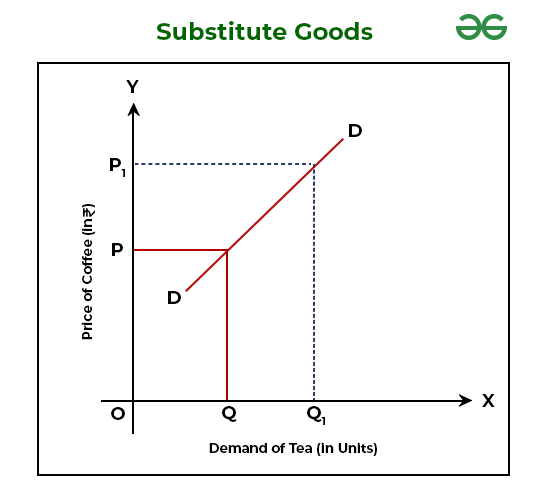What are Substitute Goods?
The goods which can be used in place of one another to satisfy a specific want, like tea and coffee are known as Substitute Goods. The price of substitute goods directly affects the demand for a given commodity. For example, if the price of a substitute good (say, coffee) increases, then demand for the given commodity (say, tea) will increase as compared to coffee.

In the above graph, the price of the substitute good (coffee) is shown on the Y-axis, and demand for the given commodity (tea) is shown on X-axis. When there is an increase in the price of coffee from OP to OP1, then the demand for tea will also increase from OQ to OQ1.
What are Complementary Goods?
The goods which are used together to satisfy a specific want, like bread and butter are known as Complementary Goods. The price of a complementary good and demand for the given commodity inversely relates to each other. For example, if the price of a complementary good (say, butter) increases, then demand for the given commodity (say, bread) will decrease as it will become costlier for the consumer to use both goods together.

In the above graph, the price of the complementary good (butter) is shown on the Y-axis and demand for the given commodity (bread) is shown on X-axis. When there is an increase in the price of butter from OP to OP1, then the demand for bread will also increase from OQ to OQ1.
Difference between Substitute Goods and Complementary Goods

| Basis | Substitute Goods | Complementary Goods |
|---|---|---|
| Meaning | The goods which can be used in place of one another to satisfy a specific want. | The goods which are used together to satisfy a specific want. |
| Nature of Demand | Substitute goods have competitive demand. | Complementary goods have joint demand. |
| Slope | The demand curve for substitute goods is upward sloping. | The demand curve for complementary goods is downward sloping. |
| Relation | The price of one substitute good has a positive relationship with the quantity demanded of another substitute good. | The price of one complementary good has a negative relationship with the quantity demanded of another complementary good. |
| Example | Pepsi and Coca-Cola, Tea and Coffee, etc. | Bread and Butter, Tea and Sugar, etc. |
Leave a Reply